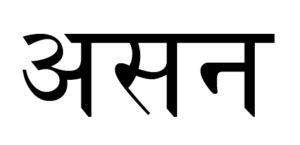The Vedas do not mention the Sanskrit word asana anywhere, though they contain the verbal root ds, meaning both “to be” and “to sit.” The connection between these two connotations is the sense of abiding. Anything that is abides. And sitting or settling down can be viewed as an intensified form of abiding.
The cognate term asandi occurs already in the Atharva-Veda (15.3.2), which in its final version must have existed by 2500 B.C.E. This refers to a “seat” or “stool.” Thus the vratya, a type of ascetic in Vedic times, is said to have sat on an asandi while contemplating life.
This term also was used in the Brdhmanas and Aranyakas, but it was not until the archaic Brihad-Arany aka-Upanishad (6.2.4), possibly the earliest text of the Upanishadic genre (c. 1500 B.C.E.?), that the synonym asana came into vogue.
The term asana is composed of the verbal root as and the neuter suffix ana, meaning literally “sitting.”
Originally, like its cognate asandi, it stood for a seat upon which the sage would settle for meditation or sacrificial rituals. This is exactly the usage in the Brihad-Aranyaka-Upanishad and also the ancient Taittiriya-Upanishad (1.11.3). However, the old Kaushitaki-Upanishad (1.3 and 5) still uses asandi instead of asana. This might be due to local usage or suggest an earlier date for this Upanishad than is normally assumed.

The Sanskrit word asana in the devanagari script
Even in the Bhagavad-Gita (6.11-12; 11.42), which belongs to c. 400-500 B.C.E., asana is still understood in the sense of a sitting platform.
The Maitrdyaniya-Upani-shad, which can be dated to c. 300 B.C.E, taught a six-limbed yogic path (shad-anga-yoga), which excluded yama (moral discipline), niyania (self-restraint), and asana (posture).
In the Yoga-Sutra of Patanjali (c. 200 C.E.), asana clearly no longer denotes “seat” but rather “posture.” Patanjali tells us (2.46) that it should be comfort-able/pleasing (sukha) and stable (sthira’). Vyasa, in his fifth-century Yoga-Bhashya commentary on the Yoga-Sutra, lists by name eleven postures, all of which appear to have been used for meditation. Patanjali recognized a-sana as the third limb of his model of the eightfold yogic path (ashta-anga-yoga).
Once asana had acquired the sense of “posture,” it first clearly referred only to meditation postures, such as the all-time favorites padma-asana (lotus posture) and siddha-dsana (accomplished posture).
With the emergence of Tantra, which primarily regarded the human body as a temple of the Divine, the way was open to the development of posture as an instrument for maintaining or restoring health.
This aspect of asana was particularly developed in the lineages of Hatha-Yoga, a branch of Tantra that emerged c. 1000 C.E. Hatha-Yoga is traditionally considered to be the invention of Goraksha Natha, who is still rememered as one of the immortal Tantric masters.

Gorakshanatha in rajalilasana on a tiger
According to him, Shiva long ago taught that there are 840,000 kinds of asana of which only 84 are particularly useful to yogins. The Hatha-Yoga-Pradipika, a widely used traditional manual dating back to the mid-fourteenth century, describes 16 postures. The Gheranda-Samhita, a seventeenth-century manual, furnishes practical details on 32.
Some modem books on Hatha-Yoga contain descriptions of 200 and more postures, and one work published in Brazil describes and illustrates a total of 2,000 postures with their variations.